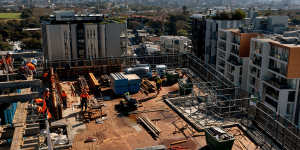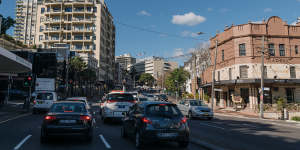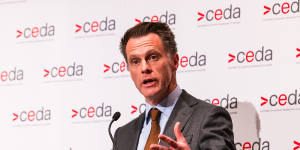Partly,this is because the government went about it a bit backwards. Rather than starting with the number of homes it wants each region and council to build over the next five years,it began with a series of complex policy reforms it hopes will get them there. This week,we finally got the targets.

The housing targets announced by the government shift the dial slowly but not dramatically toward the east and established infrastructure.Bloomberg
The Liberals have called the figures “pie-in-the-sky stuff”,and there’s a very valid discussion to be had about whether they are remotely achievable. But if by some miracle they were to be realised,would they dramatically change the look and feel of Sydney?
Well,no – not really. As,when you add up the numbers and compare the new targets with the old,the east’s share of housing growth climbs by about 2 percentage points. The west is still a big driver of new housing. And why not? People do actually want to live there. It isn’t just Plan B for people who can’t afford the east.
But if you listen to some local mayors,this is Armageddon. Richard Shields,the mayor of Woollahra and state director of the Liberal Party,says it will be “catastrophic” for his municipality to add 1900 homes in five years.
Let’s be serious. There are about 26,500 dwellings in the Woollahra local government area. Will a 7 per cent increase in five years drastically alter the eastern suburbs as we know it? I highly doubt it.

Edgecliff,in the Woollahra local government area,which is slated for an uplift in new housing under draft plans.James Brickwood
Let’s go north to Ku-ring-gai Council,a vocal opponent of the government’s planning reforms. It has been tasked with delivering 7600 new homes in five years,or about 16 per cent of its current stock of dwellings. It’s a bigger shift,certainly,in a part of Sydney not exactly renowned for its love of change. But ultimately,that’s about 3 per cent a year.
And the government has given them a toolkit – the transport-oriented development program,which rezones land around train stations – to deliver a lot of that uplift. Whether the economics stack up in the expensive north shore is another question. If they don’t,kiss those targets goodbye.
Then we go west to the Hills Shire,which has kicked up a big stink about being asked to grow by 35 per cent in five years. That’s a lot. But according to the government,three-quarters of the growth is already on the books:dwellings either under construction,approved or part of planning proposals on rezoned land.
It’s a bit cute to include planning proposals that have been lodged but not yet approved,given they are not even in the development application stage. Nonetheless,the government’s point is that the targets try to stretch the Hills,but not by magnitudes.

That’s largely true for most parts of Sydney under these new housing targets. While they require more infill development in places like the inner west,inner south and east,they do not radically restructure the face of Sydney in the way some feared or claimed. They do not turn Mosman into Kowloon.
Perhaps that’s why Opposition Leader Mark Speakman didn’t really criticise them during a press conference in the Hills District on Thursday. Instead,in a jarring scene,he stood at Showground metro station to complain there is not enough infrastructure in the Hills for more housing.
This is the same world-class metro line the former Coalition government – of which Speakman was a part – built at a cost of $7.4 billion. It runs far below capacity because it is largely surrounded by low-rise housing and fields.

Premier Chris Minns used a significant speech this week to zoom in on the consequences of failing to put downward pressure on housing costs.James Brickwood
But the Liberals – and families – have a legitimate gripe about schools. Schofields East,Box Hill/Nelson and North Kellyville were all in the top 10 student growth areas for 2018-23. Education Minister Prue Car admitted in April that communities such as Box Hill and neighbouring Gables “should have more”,blaming the Coalition for the shortage and noting a new public school was planned. Other schools are being upgraded. Still,the government will likely have to do better.
There are also questions to be asked about why there has been no increase in housing targets in some LGAs such as Randwick and Strathfield. Both happen to contain marginal Labor-held seats. Coincidence? To be fair,the target in Premier Chris Minns’ home shire,Georges River,has nearly doubled.
Predictably,much of the discussion of these new targets has framed them as Minns shifting the “burden” of housing growth to the east. We often talk this way about housing and population growth,as though it is something to be feared and resisted,rather than something that makes communities more vibrant,exciting and successful.
But in a to the Committee for Economic Development of Australia this week,Minns homed in on the consequences of failing to grow. If supply remains so far behind demand,prices and rents keep climbing. People work longer and harder for less reward. They spend more time commuting. We lose people to other states and cities. Families and generations are divided. Social mobility is undermined.
Ultimately,those things would change the look and feel of Sydney much more than a few new buildings. That would be the real catastrophe.
Michael Koziol is Sydney editor.